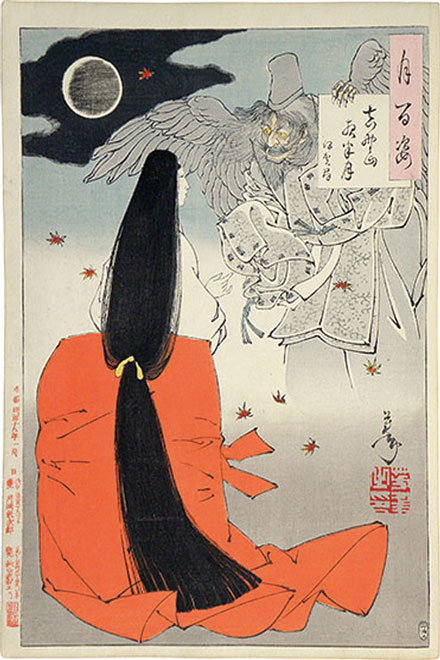
By David Yamaguchi
The North American Post
It is nearly 2017!
One thing that is on my calendar for the New Year is the total solar eclipse of August 21. This type of event—when the sun becomes a halo of filaments around a black moon—is expected to be visible for two minutes and 42 seconds in central Oregon.
One reason this eclipse is “on my list” is that I have never seen one. Another is that it may be my last opportunity. While solar eclipses occur regularly, the problem is that they only recur at a particular point on earth on average once every 375 years [1]. For example, the last one to occur over Seattle was in 1860. The next one will be in 2645.
The 2017 eclipse is known to be coming as the occurrence of these events can be calculated with precision, both forward and backward in time. The latter makes one wonder what records exist of eclipses in Japanese history. Two such events merit mention here.
One historical eclipse over Japan is related to the very origins of contemporary Japanese society. Readers may recall that the most ancient of Japanese books is the Kojiki (AD 711-712). It describes the misty origins of Yamato as a nation-state. It begins with the mythical sun-goddess Amaterasu descending from the sun.
The Kojiki continues by describing a time when Amaterasu entered a cave, and had to be lured out with a mirror. That key entry of mirrors into Japanese mythology probably explains their outsize roles in Japanese art, literature, and religion.
It turns out that there was an eclipse in Japan that could well explain the Amaterasu cave legend. It was on March 24, AD 247, and lasted a full ten minutes over Kyushu [2]. This was four centuries before dated written documents would appear across Japan—aided by the spread of literacy with Buddhism—during its Asuka period (AD 600-710).
Moving forward from that event to Meiji time, the imperial reign into which the Issei were born, we find what may be the most stunning image of a lunar eclipse in Japanese art. It is a woodblock print of a 14th-century court lady confronting a ghost in the palace garden.
The scene tells a famous ghost story, previously depicted in woodblocks by multiple artists including Katsushika Hokusai (AD 1760-1849; famous for the “Great Wave at Kanagawa”) and Utagawa Hiroshige (1797-1858; known for “Fifty-Three Stations of the Tokaido”). However, the Meiji version is the first to include what appears to be an eclipse. In fact, the image is near-perfect drawing of a “total lunar eclipse,” an eclipse where the moon’s face darkens in Earth’s shadow. This happens when the moon is too far from Earth to fully obscure the sun.
One has to wonder why the eclipse image only appears in the series of historical woodblocks in Meiji time, that is, after contact with the West is resumed after three centuries of isolation. It is possible that it is mere artistic whimsy; that its moon was not meant to be interpreted as an eclipse. Alternatively, it could be that eclipses were in the news—just as they are now—owing to international interest in the impending total solar eclipse of August 1886. That eclipse would soon traverse the equatorial Atlantic Ocean from Madagascar to Panama.
It would be fitting to end this column with a haiku about the sun or the moon. Perhaps this one suffices:
Kono tsuki o
imachi nemachi to
yobi o ori
Should this moon be
Waited for by sitting or lying down?
I calculate with my fingers.
Sujyu Takano (1893-1976) [3]
[Writer’s note]
The three main websites I consulted for this article are fascinating. For readers who want to follow up, they are:
[1] John Rao, 2014, Surprising frequency of total solar eclipses explained, Huffington Post (Apr 27).
[2] Avi Landau, 2012, Some thoughts on eclipses… blog.alientimes.org.






